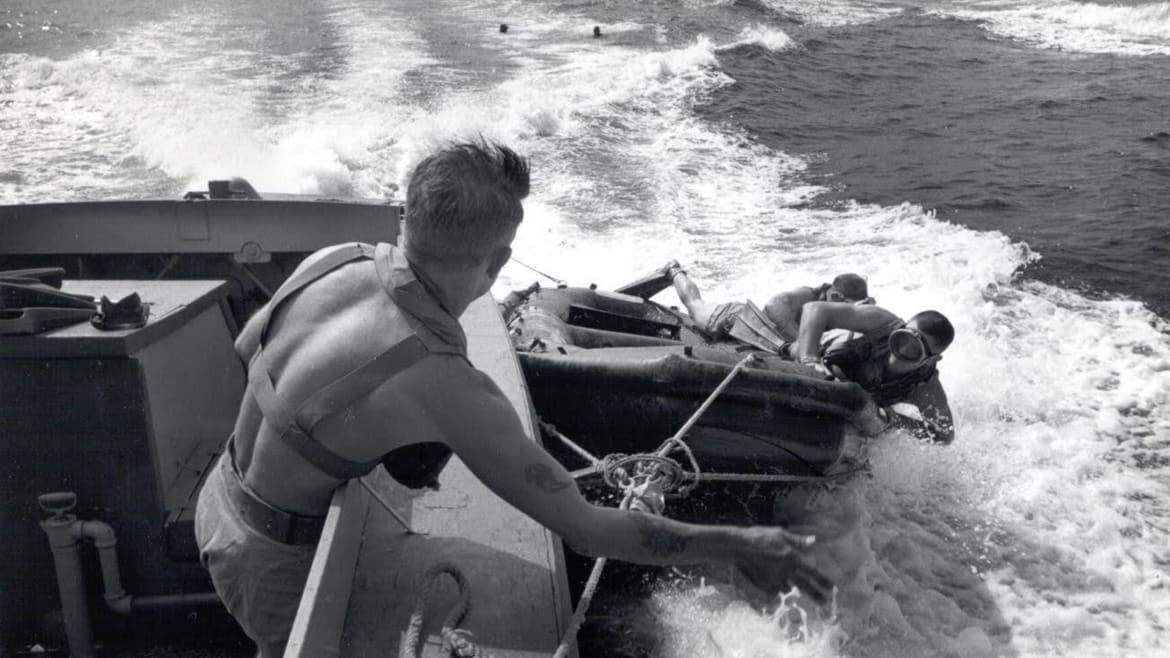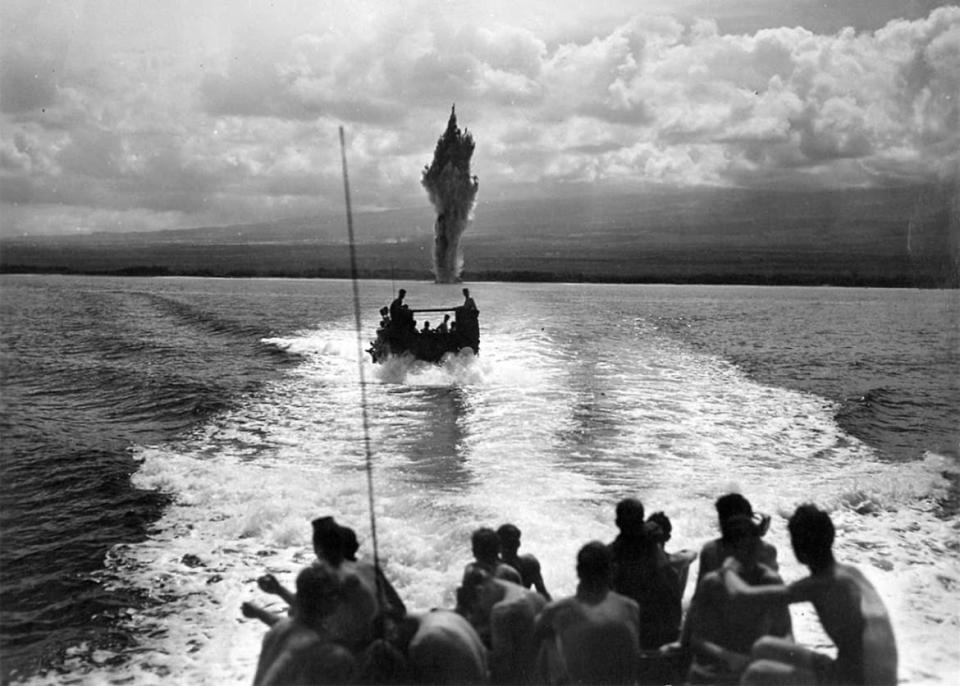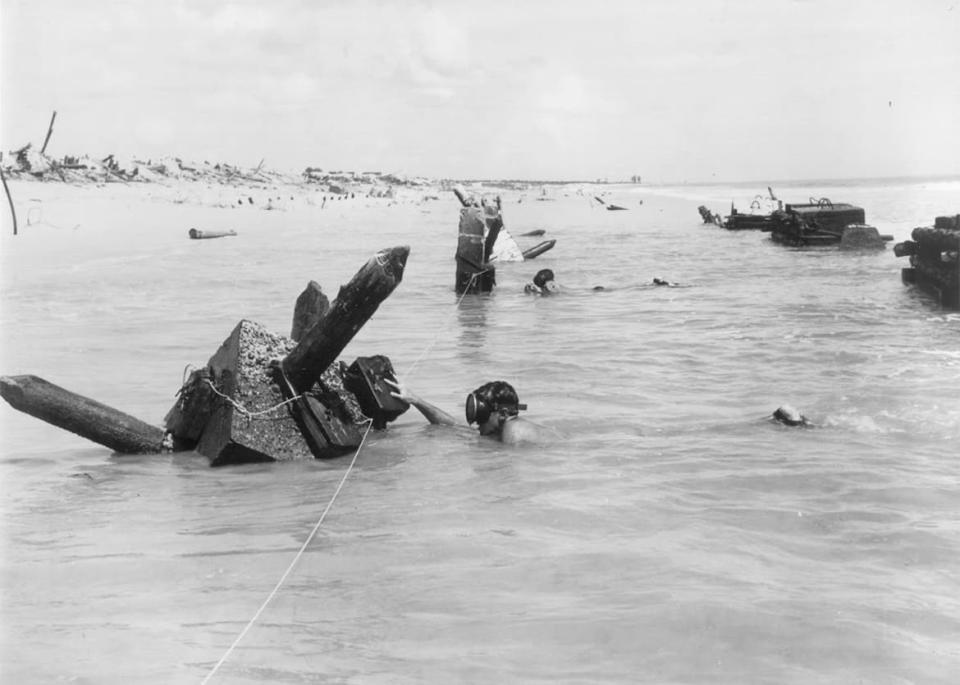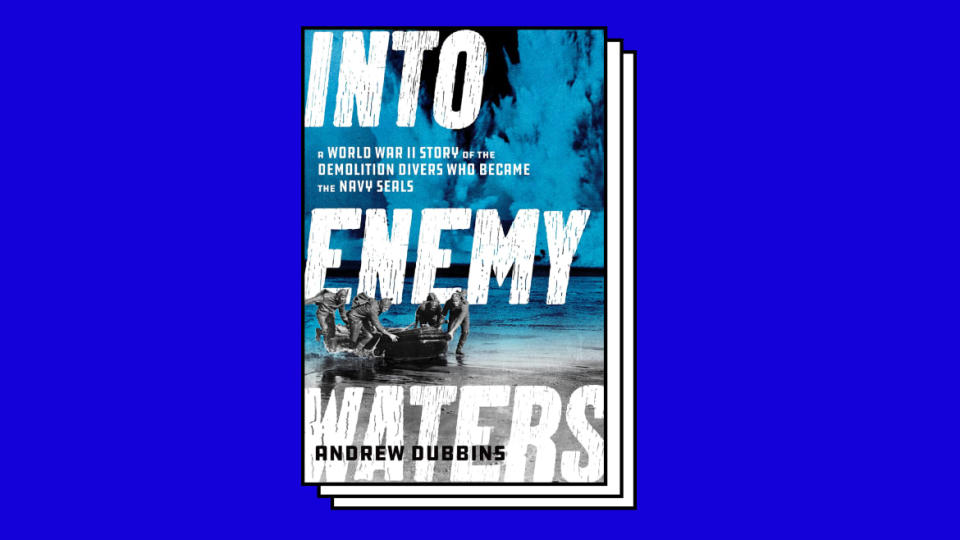Without the Heroic WWII Frogmen There Would Be No Navy SEALs

At 9 a.m. on June 14, eight days after the Normandy invasion, Lieutenant Commander Draper Kauffman and his team of frogmen motored in four landing craft toward the calm, turquoise, saltwater lagoon of Saipan. The men wore swimming trunks and were covered from head to toe in blue paint to provide camouflage in Saipan’s lagoon. Some wore knee pads and baby blue canvas shoes for crawling over the sharp coral reef. Lashed to their belts were sheave knives, as well as small charges of rubber-cased explosives for detonating mines.
It was the first large-scale daylight operation by the Navy’s Underwater Demolition Teams (UDT), an elite unit of frogmen assigned to scout enemy-held Pacific islands and blow up coastal defenses ahead of Allied landings. To this day, few people know about the unit, in large part because its existence was kept top secret during the war to prevent the Japanese from devising a countermeasure. But the contributions of the UDT were invaluable. Outfitted with just swim trunks, fins, and dive masks, the frogmen participated in nearly every major amphibious assault of the Pacific Theater. GIs admiringly called them “Half fish, half nuts.” Decades later, the daring swimmers would give rise to the Navy SEALs.
In advance of the Saipan reconnaissance, Kauffman and fellow officers had divided the swimmers into “buddy pairs,” directing them to always work together and to help each other in case of trouble. Each pair carried a reel of fishing line for measuring water depth and balsa floats for marking underwater hazards. They’d also painted black lines every twelve inches on their necks, torsos, and legs, turning their bodies into yardsticks for taking measurements in the shallows.
Osama Bin Laden Death: Navy SEALS Are the Coolest Guys in the World
Each UDT swimmer had to be his own engine, vessel, skipper, and navigator. “There’s no markers,” remembers 95-year-old George Morgan, who joined the UDT as a teenager and participated in Pacific island reconnaissance missions after Saipan. “Nobody says, ‘Turn to the right or turn here.’”
At Saipan, Navy warships were conducting a powerful bombardment of the shoreline, designed to keep the Japanese pinned down during the UDT swim operation. The palm trees overhanging the beach were quickly reduced to stubble, a look christened the “Spruance Haircut” as an homage to Fifth Fleet Commander Admiral Raymond Spruance.
Two miles offshore, and one mile seaward of the barrier reef, the UDT landing craft banked parallel to the shoreline, then UDT pairs began slipping into the water. As they swam shoreward, one man in each pair lowered the weighted fishing line to the sea bottom to record depth measurements as his partner swam in a zigzag pattern at his side, searching for underwater mines, obstacles, or shallow coral heads, and marking them with balsa floats. In the leadup to the mission, there’d been concerns about man-eating clams and enormous sharks in the lagoon, but none were observed.

Returning from a successful demolition mission off Saipan.
Kauffman and fellow officers rode ahead of the swimmers on motorized black rubber rafts, dubbed “flying mattresses,” helping coordinate the covering fire. Each raft held an officer and his swim buddy, who shared a radio and binoculars. Kauffman—who suffered terrible eyesight—wore his Coke-bottle glasses taped to his face in case he needed to plunge into the ocean. (The buddy he’d selected was farsighted, but also color blind, prompting a running joke that Kauffman’s buddy would describe the shore objects, and Kauffman would tell him the color.)
Waves spattered over the edges of the rubber rafts as they puttered across the lagoon. Kauffman’s raft was speeding shoreward when a line of shells splashed close astern. Believing it was Navy gunfire, Kauffman lifted the aerial of his cracker-box radio and furiously called up his executive officer, who was relaying coordinates to the warships from a landing craft.
“Tell those damned ships to knock off the shorts!” Kauffman barked.
“Those are not shorts, they are overs,” his executive replied calmly. “They are not ours.”
As tall columns of water lifted up like fire hydrants and bullets raked the surface of the lagoon, the swimmers porpoised underwater to escape. The men realized that enemy bullets slowed down a few feet beneath the ocean surface, allowing the swimmers to hold their breath and dive underneath the sinking ordnance. (Some swimmers caught the bullets in their fingers and tucked them into their pockets as souvenirs. Others would later drill a hole through the sniper bullets, tie them on strings, and wear them as necklaces.)
Even as enemy shellfire and bullets peppered the water, Kauffman could see many swimmers continuing toward the beach to within fifty yards. Awed by their courage, he’d later say, “Every single man was calmly and slowly continuing his search and marking his slate… I would not have been so amazed if 90 percent of the men had done so well, but to have a cold 100 percent go in through the rain of fire was almost unbelievable.”

WWII frogmen practice detonating shore obstacles.
One man was killed during the morning reconnaissance, a popular officer named Robert Christensen. He’d been struck by a Japanese bullet while piloting one of the rubber rafts.
“After each mission, there was always going to be one or two empty bunks,” recalls Morgan, now one of the last surviving Veterans of the UDT. “You lived with that, and it was tough.”
Back aboard the transports, officers collected the swimmers’ intelligence and depth measurements, and Kauffman’s best draftsman created a detailed chart of Saipan’s lagoon, copies of which were distributed to landing forces. The next morning, UDT officers rode in small boats ahead of the infantry to guide them into their assigned landing beaches.
Kauffman led in the amphibious tanks from an open-topped amtrac. Even as enemy mortar shells splashed around him, Kauffman coolly kept about his work, dropping buoys and anchors to mark a diagonal channel across the reef. Behind him, the long line of tanks bobbed along the buoyed undersea path, following Kauffman’s amtrac like ducklings on a pond.

After guiding the tanks ashore, Kauffman was instructed to report to the shore commander, who had an assignment for him. Stepping out of an amtrac onto the beach, Kauffman and a UDT lieutenant found themselves in the middle of a fierce firefight. The beach was a cauldron of smoke, white phosphorous, and clouds of exploding sand. Each Marine looked like a one-man war, armed with rifle, bayonet, ammo clips, fighting knife, incendiary and phosphorus grenades.
Kauffman and the lieutenant leaped into a foxhole in the sand between two sweaty, helmeted Marines. The Marines had to blink hard to believe what they were seeing: bare-torso Kauffman and the lieutenant in swim trunks and “coral shoes,” with dive masks dangling around their necks.
“For heaven’s sake,” one Marine yelled to the other. “We don’t even have the beachhead yet, and the goddamn tourists have already arrived!”
Adapted from Into Enemy Waters: A World War II Story of the Demolition Divers Who Became the Navy SEALs by Andrew Dubbins. Copyright © 2022 Andrew Dubbins. Printed with permission of the publisher, Diversion Books. All rights reserved.
Get the Daily Beast's biggest scoops and scandals delivered right to your inbox. Sign up now.
Stay informed and gain unlimited access to the Daily Beast's unmatched reporting. Subscribe now.


